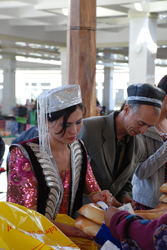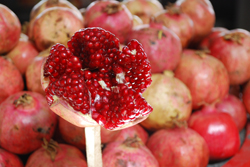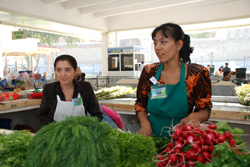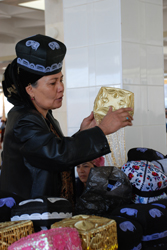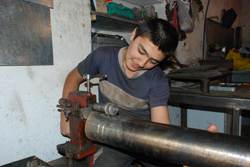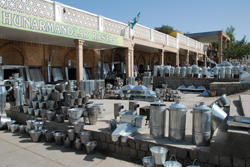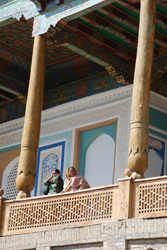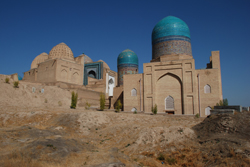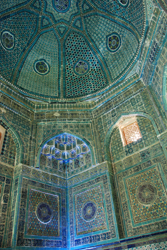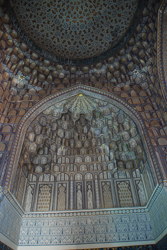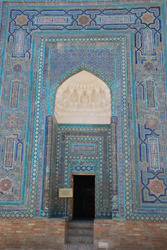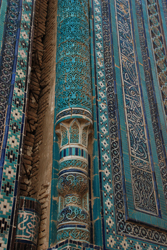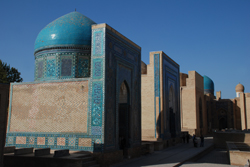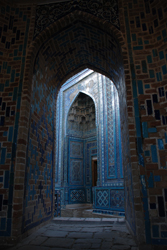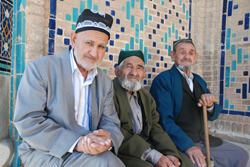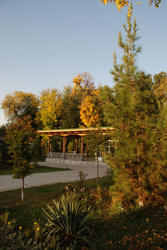Samarkand: Guys, Girls and the Shah-I-Zinda
5 October, 2008, 04:45 am in "Uzbekistan"
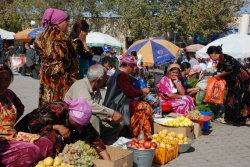 For our ride from the border to Samarkand, the other passenger in our taxi was a 2nd wife in a polygamous marriage. Her husband had 2 wives and she was the youngest. She had been talking about multiple wives and had said, “There is war if he can't support them.” We asked her if there is ever war between her and the other wife. She said, “No” and that her husband was a good man and supported them both as well as all their children. And she was dressed well (though women here usually are). She told us Samarkand makes the best bread and highly recommended the sweets.
For our ride from the border to Samarkand, the other passenger in our taxi was a 2nd wife in a polygamous marriage. Her husband had 2 wives and she was the youngest. She had been talking about multiple wives and had said, “There is war if he can't support them.” We asked her if there is ever war between her and the other wife. She said, “No” and that her husband was a good man and supported them both as well as all their children. And she was dressed well (though women here usually are). She told us Samarkand makes the best bread and highly recommended the sweets.The best place to find bread in Samarkand is the Siob Bazaar: a clean and attractive open bazaar with marble vendor tables, white ceiling and a bread area with carved wooden columns. The market is kept clean by sweepers who patrol the aisles disregarding any shoppers feet or bags in their way. It's filled with good smells and attractively arranged foods. We bought some pomegranates which Rowshan squeezed in their skins into juice.
Rowshan got into a conversation with some women who were giggling about his hair (thinking he wouldn't understand). Somehow the conversation turned to how he could marry 4 of them and the one who was caught laughing about his hair would have the job of combing it. One would cook, another make salad (they were greens vendors) but when he asked who'd clean, one pointed at me. I guess I'd better watch out for these Uzbek/Tajik women.
A couple days later, at one of our Internet cafe stops, Rowshan pointed out a young man peering over the shoulder of a young woman chatting using a messenger program. Rowshan laughed, “We used to do that at the computer center to get the user names of people and send them messages.” Then, while checking my Facebook account, I saw I had a message from an Uzbek guy 20 years younger than me which simply said, “Hi”. I joked to Rowshan that if he was going to collect potential wives at the bazaar, I was going to collect young computer guys at Internet cafes.
Back at the bazaar, a spice vendor tried to sell Rowshan saffron to which he replied, “I'm from Iran. The best saffron is from Mashad, Iran.” Then he tried to sell cumin to which Rowshan replied, “The best cumin is from Kerman, also in Iran.” Aside from food, there were also women selling traditional Uzbek hats.
Back at the bazaar, a spice vendor tried to sell Rowshan saffron to which he replied, “I'm from Iran. The best saffron is from Mashad, Iran.” Then he tried to sell cumin to which Rowshan replied, “The best cumin is from Kerman, also in Iran.” Aside from food, there were also women selling traditional Uzbek hats.
We found an open air cafe and got plov, salad, and tea. It was a popular place so when Rowshan saw to old men with long white beards carrying soup bowls, he offered them places at our table. They tourists as well, visiting from “Leninbad”. It took us a little while to figure out they were from Khojand which used to be called Leninbad.
Across from the bazaar, we found some metal workers. These were practical metal workers, not souvenir makers. They were making tools: scythes, shovel heads, hoe heads as well as aluminum pipes, boxes and sink structures. They all called over to us and wanted to chat, especially when they found out Rowshan spoke Farsi (we are in a predominantly Tajik speaking area still). After that we peeked at the Hazrat-Hizr Mosque which has a beautiful painted ceiling.
Across from the bazaar, we found some metal workers. These were practical metal workers, not souvenir makers. They were making tools: scythes, shovel heads, hoe heads as well as aluminum pipes, boxes and sink structures. They all called over to us and wanted to chat, especially when they found out Rowshan spoke Farsi (we are in a predominantly Tajik speaking area still). After that we peeked at the Hazrat-Hizr Mosque which has a beautiful painted ceiling.
Shah-I-Zinda
The Shah-I-Zinda complex is a narrow avenue of mausoleums, most decorated with tiles of glazed terracotta work. There are a huge variety of decorative styles. Some have tile-work inside and out, others are just white washed (maybe they were tiled but the tile-work got destroyed), and others are filled with painted designs.
We spent quite a while wandering through. The last section had two mausoleums with beautiful glazed terracotta designs-- a colored glass covered version of the type of clay work we'd seen at Aysha Bibi in Taraz and Uzgen. The most religiously important mausoleum though is for Mohamad's cousin Abbas who is credited for spreading Islam in Central Asia. It contained a mosque, prayer room, and the tomb. In the prayer room a man sang prayers while everyone sat absorbing the beauty of the space.
We walked back into the center and then towards the Russian part of town because I needed to use the Internet. One of the wonderful things about Samarkand was it was a city with its own history and identity before the Russians got here. It feels more like a Middle Eastern city like Istanbul, cities in Iran and Morocco. It has an appreciation for beauty and culture and a strong Central Asian character instead of Soviet. That said, there is a Russian area with straight tree lined streets and Russian/Soviet buildings. It also has cafes, restaurants and a pretty park. Everything closed early Sunday night, but we did get some hot Samarkand bread which is delicious, cheese, tomatoes and cucumbers.
[ View 2 Comments
|
]
Comments
michelle tavakoli -
posted on 3/23/2009
WHAT A FANTASTIC TRIP IT MUST OF BEEN! THE BIT A WAY BACK ABOUT THE WOMEN AT THE GREEN VEGETABLE SELLERS AND THE COMPUTER CAFE GUY WAS TRUELY FUNNY! THAT ONE GIRL LOOKED LIKE SHE WAS RICH WITH ALL THAT GOLD TEETH! AND THE SHAH l ZENDA IS TRUELY BREATHTAKINGLY AWESOME!
michelle tavakoli -
posted on 3/23/2009
WHAT AN AMAZING TRIP THAT MUST OF BEEN! IT WAS TRUELY FUNNY YOUR EXPERIENCES WITH THE FEMALE VEGETABLE VENDORS AND THE COMPUTER GUY! THE SHAH-I-ZENDA IS BREATHTAKINGLY BEAUTIFUL, TO SAY THE LEAST, AND MY FAVORITE ONE SO FAR.. THE PLACE OF DANIEL TOMB WAS WEIRD HOW LARGE IT WAS AND ALL


